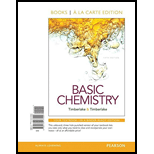
Concept explainers
(a)
Interpretation:
The shape and polarity of molecule containing central atom having 3 identical bonds and one lone pair needs to be determined.
Concept Introduction:
The Lewis dot structure is the representation of a molecule or compound in which atoms are arranged or bonded in such a way that all the atoms have complete octets.
The bond formation between the atoms takes place due to the sharing of valence electrons between them while the remaining outer electrons are denoted as lone pair of electrons.
(b)
Interpretation:
The shape and polarity of molecule containing central atom with 2 identical bonds and 2 lone pairs needs to be determined.
Concept Introduction:
The Lewis dot structure is the representation of a molecule or compound in which atoms are arranged or bonded in such a way that all the atoms have complete octets.
The bond formation between the atoms takes place due to the sharing of valence electrons between them while the remaining outer electrons are denoted as lone pair of electrons.
Want to see the full answer?
Check out a sample textbook solution
Chapter 10 Solutions
Basic Chemistry, Books a la Carte Edition (5th Edition)
 ChemistryChemistryISBN:9781305957404Author:Steven S. Zumdahl, Susan A. Zumdahl, Donald J. DeCostePublisher:Cengage Learning
ChemistryChemistryISBN:9781305957404Author:Steven S. Zumdahl, Susan A. Zumdahl, Donald J. DeCostePublisher:Cengage Learning ChemistryChemistryISBN:9781259911156Author:Raymond Chang Dr., Jason Overby ProfessorPublisher:McGraw-Hill Education
ChemistryChemistryISBN:9781259911156Author:Raymond Chang Dr., Jason Overby ProfessorPublisher:McGraw-Hill Education Principles of Instrumental AnalysisChemistryISBN:9781305577213Author:Douglas A. Skoog, F. James Holler, Stanley R. CrouchPublisher:Cengage Learning
Principles of Instrumental AnalysisChemistryISBN:9781305577213Author:Douglas A. Skoog, F. James Holler, Stanley R. CrouchPublisher:Cengage Learning Organic ChemistryChemistryISBN:9780078021558Author:Janice Gorzynski Smith Dr.Publisher:McGraw-Hill Education
Organic ChemistryChemistryISBN:9780078021558Author:Janice Gorzynski Smith Dr.Publisher:McGraw-Hill Education Chemistry: Principles and ReactionsChemistryISBN:9781305079373Author:William L. Masterton, Cecile N. HurleyPublisher:Cengage Learning
Chemistry: Principles and ReactionsChemistryISBN:9781305079373Author:William L. Masterton, Cecile N. HurleyPublisher:Cengage Learning Elementary Principles of Chemical Processes, Bind...ChemistryISBN:9781118431221Author:Richard M. Felder, Ronald W. Rousseau, Lisa G. BullardPublisher:WILEY
Elementary Principles of Chemical Processes, Bind...ChemistryISBN:9781118431221Author:Richard M. Felder, Ronald W. Rousseau, Lisa G. BullardPublisher:WILEY





